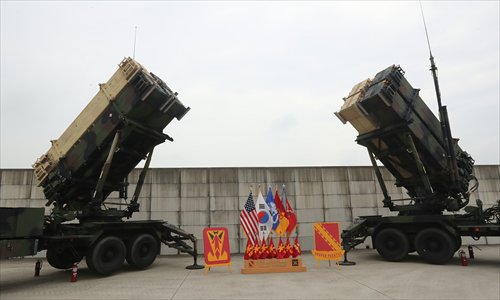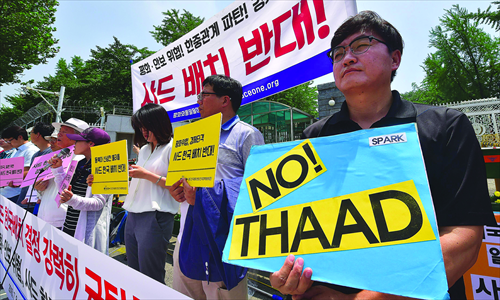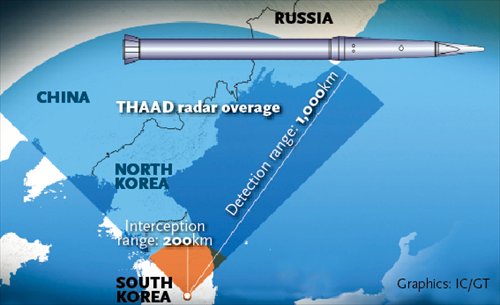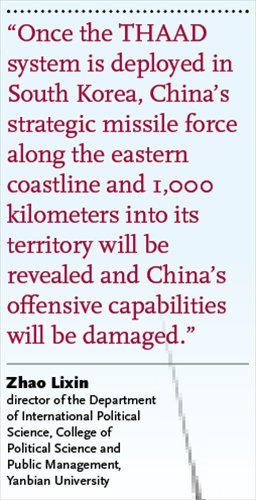US eye in South Korea
Experts warn that THAAD could allow Washington to surveil China’s missile capabilities
The planned deployment of a US-built missile defense system in South Korea has created headaches for some countries in Northeast Asia. While South Korea maintains that the deployment is solely a response to repeated North Korean missile tests, experts worry it will inevitably alter the geopolitical balance in the tense region.

US missile launchers deployed in the South Korean city of Osam. Photo: IC
China and Russia have strongly objected to the presence of the Terminal High Altitude Area Defense (THAAD) anti-missile system in South Korea, ever since Washington and Seoul announced its deployment in early July.
Though no concrete measures have been taken in response, there are rumors that South Korean TV shows may find it harder to get on Chinese screens, and the city of Qingdao has reportedly decided not to send a delegation to a planned beer and chicken festival in Daegu, South Korea which was meant to boost ties. This comes amid calls on Chinese social media for boycotts of South Korean goods and cultural products and academic calls for official sanctions.
Russia's foreign ministry has warned that the deployment of THAAD, developed by the US-based arms manufacturer Lockheed Martin, will have "irreparable consequences" and will "undermine stability in the region," AFP reported.
Some analysts have claimed that the deployment risks disrupting the precarious military balance in the region, and may cause the already tense situation on the Korean Peninsular to deteriorate.
This may even lead to an arms race in the region as more impetus is added to countries' desire to out-do each other in terms of missile deterrents, Jin Qiangyi, director of the Asia Studies Center at Yanbian University, shared with the Global Times.

Anti-war activists hold placards during a rally against the planned deployment of the US-built THAAD system, outside South Korea's defense ministry in Seoul on July 8. Photo: CFP
A risky step
The topic of THAAD has long been contentious in Northeast Asia. Lockheed Martin says the system is designed to shoot down short- and medium-range ballistic missiles.
Ever since the system was ready for deployment in 2005, there have been suggestions it might be placed in South Korea. But South Korea resisted this for years out of fears of upsetting its neighbors.
But Seoul changed its mind about THAAD following Pyongyang's provocative tests. According to Jin Qiangyi, South Korea reacted in this way because it believes that China has not done enough to curb North Korea's nuclear and missile programs.
The announced deployment of THAAD follows a series of nuclear and ballistic missile tests conducted by North Korea. Pyongyang launched intermediate-range Nodong ballistic missiles again Wednesday, with one apparently exploding shortly after launch and the other reportedly landing either in, or near, Japanese waters for the first time.
Speaking to senior presidential secretaries, South Korean President Park Geun-hye said after the announcement of the deployment that North Korea's threats are "life-threatening issues" for the future of the South Korean people, CNN reported.
"There is no reason for us to use THAAD against or intrude on security interests of a third party country besides North Korea," she added.
"At first it might have just wanted to irritate China. But South Korea has gone too far this time. After North Korea's fourth nuclear test, it chose this dangerous move. Now the situation is getting out of control," Jin Qiangyi told the Global Times.
The South Korean government faced both foreign opposition and domestic concerns from those living near the system who worry about the impact that the radar system will have on their health.
Many analysts argue that South Korea's move will only create further discord in the region and will bring further risks to the security and economy of the country.

Offensive moves
Even though South Korea has argued that THAAD is a specific response to the threat from the North, Chinese military experts have voiced concerns that the system's radar function will be able to detect launches of Chinese missiles from the mainland, giving the US greater advance warning in case of nuclear war and weakening China's nuclear deterrent.
"At first, through the deployment of THAAD, South Korea wants to be sure that the US can provide it with complete nuclear protection. Whether THAAD can defend South Korea's national security is another thing and is secondary," Jin Qiangyi argued.
"The US uses South Korea as a bridgehead, and uses THAAD deployment in South Korea to monitor China and Russia's space launches and future missile launches. It is not about defense anymore, it is attack," Jin Yinan, a professor with The College of Defense Studies, told news portal cnr.cn in an interview.
Sergey Luzyanin, deputy director of the Far East Institute of the Russian Academy of Sciences, told the Xinhua News Agency that THAAD is a provocation against China and Russia. To Luzyanin, the US "attempts to use THAAD deployment to lay siege to China and Russia from East to West."
"Once the THAAD system is deployed in South Korea, China's strategic missile force along the eastern coastline and 1,000 kilometers into its territory will be revealed and China's offensive capabilities will be damaged," Zhao Lixin, director of the Department of International Political Science, College of Political Science and Public Management, Yanbian University, wrote in an article previously published in the Global Times.
Further more, according to Jin Yinan, this deployment will strongly impact the security situation in Northeast Asia and the resulting imbalance will lead to significant military adjustments in the region.
"The deployment will break the strategic balance among China, Russia and the US since THAAD could help the US to contain China's military development and watch over Russia's military forces in the Far East," Lü Chao, a research fellow with the Liaoning Academy of Social Sciences, said in a previous interview.
"South Korea is seen as the weakest point of the US-Japan-South Korea allegiance, now the deployment of THAAD will for sure strengthen the allegiance between the US, Japan and South Korea. While the relations between China and South Korea are affected. On the other hand, China and Russia might have more strategic cooperation."
Some have argued that THAAD will actually hinder international efforts to solve the North Korean issue.
"China has agreed with the US and South Korea to impose sanctions on North Korea within the UN process on denuclearization, but the US deployment may cause tensions with the US and South Korea and ease pressure on North Korea," Lü noted.

Starting a new Cold War
An arms race is on the cards also. On July 8, after the US and South Korea made the joint announcement about the deployment, Yang Yujun, spokesman for the Ministry of National Defense, said that China will pay close attention to the moves from the US and South Korea, and will consider adopting necessary measures to maintain the national security and the strategic balance in the region.
Russia's Arms Committee in the Russian Federation Council, the upper house of the country's parliament, on July 8 warned that missile units could be deployed in eastern Russia in response to the deployment of THAAD, as Xinhua reported.
North Korea has threatened to "physically act" against THAAD and make the US and its allies in the region "suffer from a nightmare of extreme uneasiness and terror," CNN reported.
"The strategic balance in Northeast Asia lies in that no big country in this area has absolute advantage over others. Now the US and South Korea have an extra shield to confront China and Russia's guns. … The US realizes its growth of strength in Northeast Asia, but the major danger is it increases the tension in this area and opens the door to an arms race in this region," Dai Xu, an air force colonel and military strategist, once told the Global Times.
According to Jin Qiangyi, as an new link in the chain of the US' global defense system, the deployment of THAAD in South Korea "probably will trigger a new Cold War."
"From the angle of the US, the previous structure of Cold War is mostly restored," Jin told the Global Times, "But it is not so easy to form a Cold War today, as countries are highly connected to each other economically."